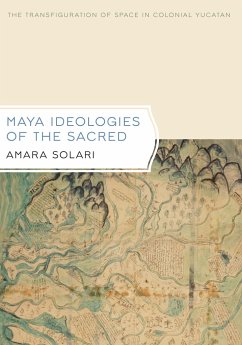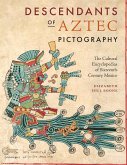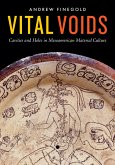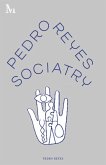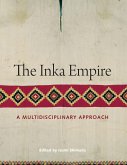Amara Solari
Maya Ideologies of the Sacred: The Transfiguration of Space in Colonial Yucatan
Amara Solari
Maya Ideologies of the Sacred: The Transfiguration of Space in Colonial Yucatan
- Gebundenes Buch
- Merkliste
- Auf die Merkliste
- Bewerten Bewerten
- Teilen
- Produkt teilen
- Produkterinnerung
- Produkterinnerung
Using the Maya city of Itzmal as a case study, this book explores how indigenous conceptions of space and landscape both aided and subverted the Franciscan evangelical effort in Colonial Yucatan.
Andere Kunden interessierten sich auch für
![Creating Pátzcuaro, Creating Mexico: Art, Tourism, and Nation Building Under Lázaro Cárdenas Creating Pátzcuaro, Creating Mexico: Art, Tourism, and Nation Building Under Lázaro Cárdenas]() Jennifer JollyCreating Pátzcuaro, Creating Mexico: Art, Tourism, and Nation Building Under Lázaro Cárdenas80,99 €
Jennifer JollyCreating Pátzcuaro, Creating Mexico: Art, Tourism, and Nation Building Under Lázaro Cárdenas80,99 €![Descendants of Aztec Pictography: The Cultural Encyclopedias of Sixteenth-Century Mexico Descendants of Aztec Pictography: The Cultural Encyclopedias of Sixteenth-Century Mexico]() Elizabeth Hill BooneDescendants of Aztec Pictography: The Cultural Encyclopedias of Sixteenth-Century Mexico63,99 €
Elizabeth Hill BooneDescendants of Aztec Pictography: The Cultural Encyclopedias of Sixteenth-Century Mexico63,99 €![Painted Cloth: Fashion and Ritual in Colonial Latin America Painted Cloth: Fashion and Ritual in Colonial Latin America]() Blanton Museum of ArtPainted Cloth: Fashion and Ritual in Colonial Latin America47,99 €
Blanton Museum of ArtPainted Cloth: Fashion and Ritual in Colonial Latin America47,99 €![Vital Voids: Cavities and Holes in Mesoamerican Material Culture Vital Voids: Cavities and Holes in Mesoamerican Material Culture]() Andrew FinegoldVital Voids: Cavities and Holes in Mesoamerican Material Culture56,99 €
Andrew FinegoldVital Voids: Cavities and Holes in Mesoamerican Material Culture56,99 €![Pedro Reyes Pedro Reyes]() Pedro ReyesPedro Reyes34,00 €
Pedro ReyesPedro Reyes34,00 €![The Inka Empire: A Multidisciplinary Approach The Inka Empire: A Multidisciplinary Approach]() Izumi ShimadaThe Inka Empire: A Multidisciplinary Approach76,99 €
Izumi ShimadaThe Inka Empire: A Multidisciplinary Approach76,99 €![Violeta Parra Violeta Parra]() Lorna DillonVioleta Parra91,99 €
Lorna DillonVioleta Parra91,99 €-
-
-
Using the Maya city of Itzmal as a case study, this book explores how indigenous conceptions of space and landscape both aided and subverted the Franciscan evangelical effort in Colonial Yucatan.
Hinweis: Dieser Artikel kann nur an eine deutsche Lieferadresse ausgeliefert werden.
Hinweis: Dieser Artikel kann nur an eine deutsche Lieferadresse ausgeliefert werden.
Produktdetails
- Produktdetails
- Latin American and Caribbean A
- Verlag: University of Texas Press
- New
- Seitenzahl: 244
- Erscheinungstermin: 1. Juli 2013
- Englisch
- Abmessung: 261mm x 184mm x 27mm
- Gewicht: 746g
- ISBN-13: 9780292744943
- ISBN-10: 0292744943
- Artikelnr.: 36622686
- Herstellerkennzeichnung
- Libri GmbH
- Europaallee 1
- 36244 Bad Hersfeld
- 06621 890
- Latin American and Caribbean A
- Verlag: University of Texas Press
- New
- Seitenzahl: 244
- Erscheinungstermin: 1. Juli 2013
- Englisch
- Abmessung: 261mm x 184mm x 27mm
- Gewicht: 746g
- ISBN-13: 9780292744943
- ISBN-10: 0292744943
- Artikelnr.: 36622686
- Herstellerkennzeichnung
- Libri GmbH
- Europaallee 1
- 36244 Bad Hersfeld
- 06621 890
These are the recollections of Alexandre—of his life, his death-in-life, and his ultimate death, as they are played out against the mobile tapestry of the valley where he was born. The valley itself, in the backlands of the state of Bahia, Brazil, alternates at different stages in Alexandre’s consciousness between reality and symbol. It swings from a harsh regional specificity to become the panorama of all human life, its endless, eroding wind the devouring hostility of all environments and its pain the pain of every human being in the face of his own brutality and that of others. Throughout the novel Alexandre’s mind ranges from sharp awareness, through hallucination, to oblivion (“a man dies while alive,” says Jeronimo, his mentor), and back again as he experiences the violent, obtuse phenomena of life in the valley—his universe and ours. This latter-day Lazarus leaves the resisting hills and black sky once only, hounded by the valley dwellers who believe he has murdered his wife, her father, and her brother. Yet despite his awareness of the horror of the valley and his intuition of something beyond it, it is precisely his contact with the gentler existence to which he escapes that forces Alexandre to recognize his nature for what it is. Turning his back on a greater and more varied range of feeling and experience, he chooses the narrow ferocity of the valley, to which he returns to die the final death for which the earlier deaths have prepared him.
* Acknowledgments
* A Note on Orthography
* Chapter 1: Spatial Conquests of the Yucatan Peninsula
* Chapter 2: The Ritualized Landscape of Pre-Columbian Itzmal
* Chapter 3: Animated Landscapes in Text and Image
* Chapter 4: Cartographic Narrative and Maya Spatial Ideologies in
Literature
* Chapter 5: Circular Cosmologies and Colonial Maya Cartographic
Practice
* Chapter 6: The Transfiguration of Colonial Itzmal
* Conclusion: The Seventeenth-Century Transference of Locative Power
* Notes
* Bibliography
* Index
* A Note on Orthography
* Chapter 1: Spatial Conquests of the Yucatan Peninsula
* Chapter 2: The Ritualized Landscape of Pre-Columbian Itzmal
* Chapter 3: Animated Landscapes in Text and Image
* Chapter 4: Cartographic Narrative and Maya Spatial Ideologies in
Literature
* Chapter 5: Circular Cosmologies and Colonial Maya Cartographic
Practice
* Chapter 6: The Transfiguration of Colonial Itzmal
* Conclusion: The Seventeenth-Century Transference of Locative Power
* Notes
* Bibliography
* Index
* Acknowledgments
* A Note on Orthography
* Chapter 1: Spatial Conquests of the Yucatan Peninsula
* Chapter 2: The Ritualized Landscape of Pre-Columbian Itzmal
* Chapter 3: Animated Landscapes in Text and Image
* Chapter 4: Cartographic Narrative and Maya Spatial Ideologies in
Literature
* Chapter 5: Circular Cosmologies and Colonial Maya Cartographic
Practice
* Chapter 6: The Transfiguration of Colonial Itzmal
* Conclusion: The Seventeenth-Century Transference of Locative Power
* Notes
* Bibliography
* Index
* A Note on Orthography
* Chapter 1: Spatial Conquests of the Yucatan Peninsula
* Chapter 2: The Ritualized Landscape of Pre-Columbian Itzmal
* Chapter 3: Animated Landscapes in Text and Image
* Chapter 4: Cartographic Narrative and Maya Spatial Ideologies in
Literature
* Chapter 5: Circular Cosmologies and Colonial Maya Cartographic
Practice
* Chapter 6: The Transfiguration of Colonial Itzmal
* Conclusion: The Seventeenth-Century Transference of Locative Power
* Notes
* Bibliography
* Index

